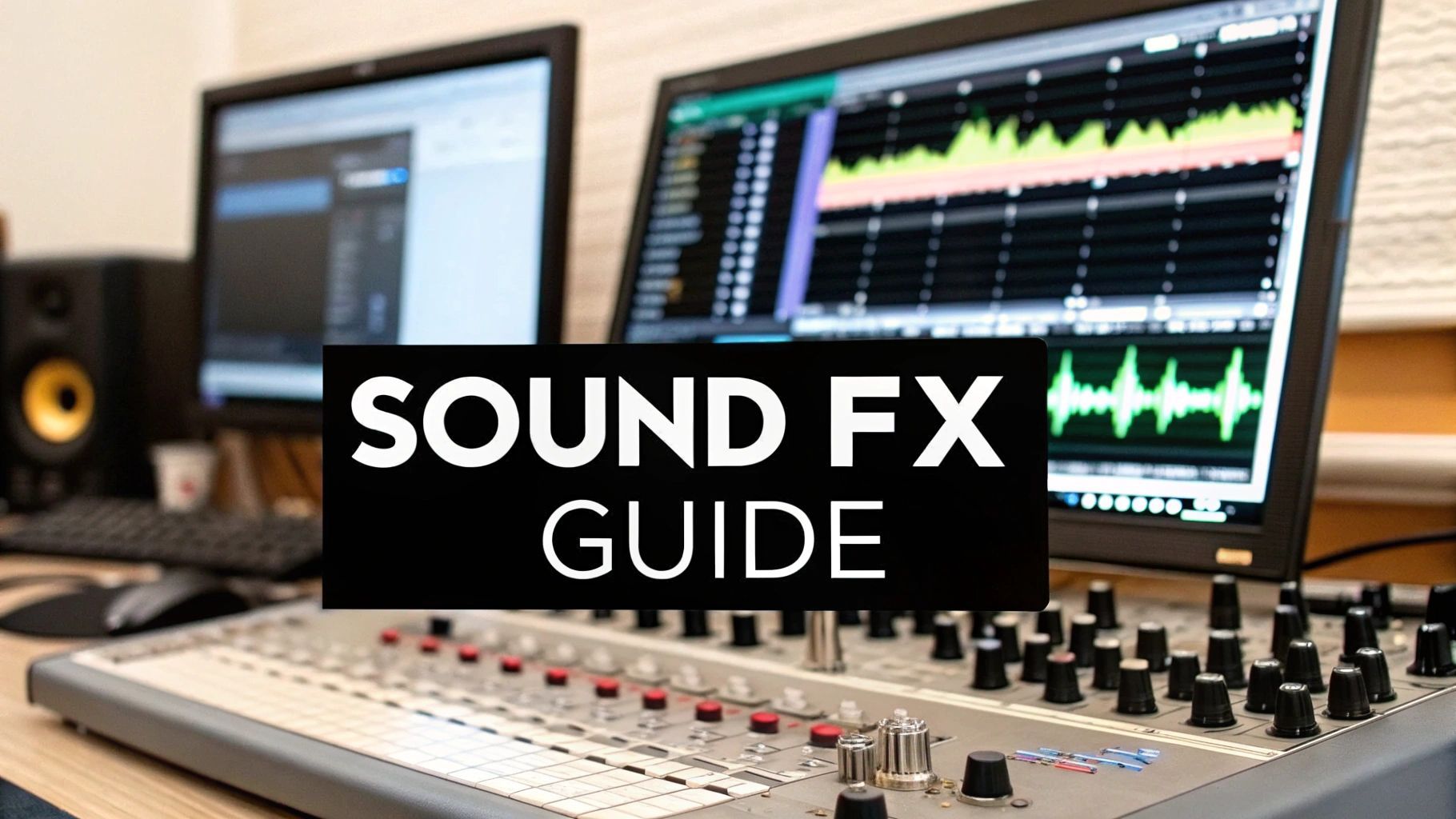
When we talk about sound effects video editing, we’re really talking about the art of making a video feel real. It’s the strategic placement and mixing of audio to dial up the emotion, ground the scene in reality, and drive the story forward. This isn't just about adding background noise; it's about choosing the perfect sounds—from the faintest ambient whisper to a gut-punching impact—to shape how your audience experiences what they see.
Ever notice how a simple whoosh sound in a movie trailer can make a scene transition feel explosive and exciting? That’s the magic of sound design. It’s the invisible craft that takes a video from looking like a hobby project to feeling like a professional production.
Without deliberate sound design, even the most stunning visuals can fall flat. A video might look beautiful, but it will feel hollow and distant, failing to truly pull the viewer in. Sound is what breathes life into the pixels.
Sound design works on a deeply psychological level. Our brains are hardwired to connect sounds with real-world experiences, and a skilled editor uses that to build a believable world on screen. It’s the difference between merely seeing a car door close and truly feeling the solid, heavy thud as it latches. This isn’t just about making noise; it’s a fundamental part of the storytelling process.
Every single sound effect should have a job to do. When done right, sound accomplishes things that visuals alone just can't.
A fight scene is the perfect example. The choreography might be brilliant, but it's the crisp thwack of a punch, the frantic scuff of shoes on the ground, and the pained grunts that truly sell the intensity.
This skill is more in-demand than ever. The audio and video editing market is on track to hit around $15 billion in 2025 and is projected to grow at a compound annual rate of 12% through 2033. That growth is all about the soaring demand for high-quality content.
To keep up, you need the right tools. Many of the best apps for content creators now come with powerful audio features built-in.
Ultimately, getting a handle on sound design is your first real step toward making videos that don't just get watched, but get felt. To go deeper, you can explore our full guide on what is sound design.
A well-organized sound library is a video editor's best friend. Seriously. It’s the one thing that can turn a frustrating, hours-long search for the perfect sound into a quick, creative win. Having the right SFX on deck when you need it is the secret to efficient sound effects video editing.
Think of your library like a professional kitchen. Everything has its place—spices, knives, pans—all within arm's reach. Without that system, you're just rummaging through cluttered drawers, burning time you could be spending on the actual edit.
First things first, you need to decide where you're getting your sounds. This really boils down to two main paths: free community sites or paid subscription services. Each has its own set of pros and cons you need to weigh.
Free platforms like Freesound are fantastic community-driven resources. You can find millions of user-uploaded sounds, including some really weird and wonderful stuff you'll never find in a commercial library. But there's a catch. The quality can be all over the place, and licensing is a potential nightmare. You have to spend time checking each file to make sure it's clean enough to use and that you're following the specific Creative Commons license, which almost always means giving credit somewhere.
Here’s a look at the Freesound interface. As you can see, it’s all about nailing the right search terms.
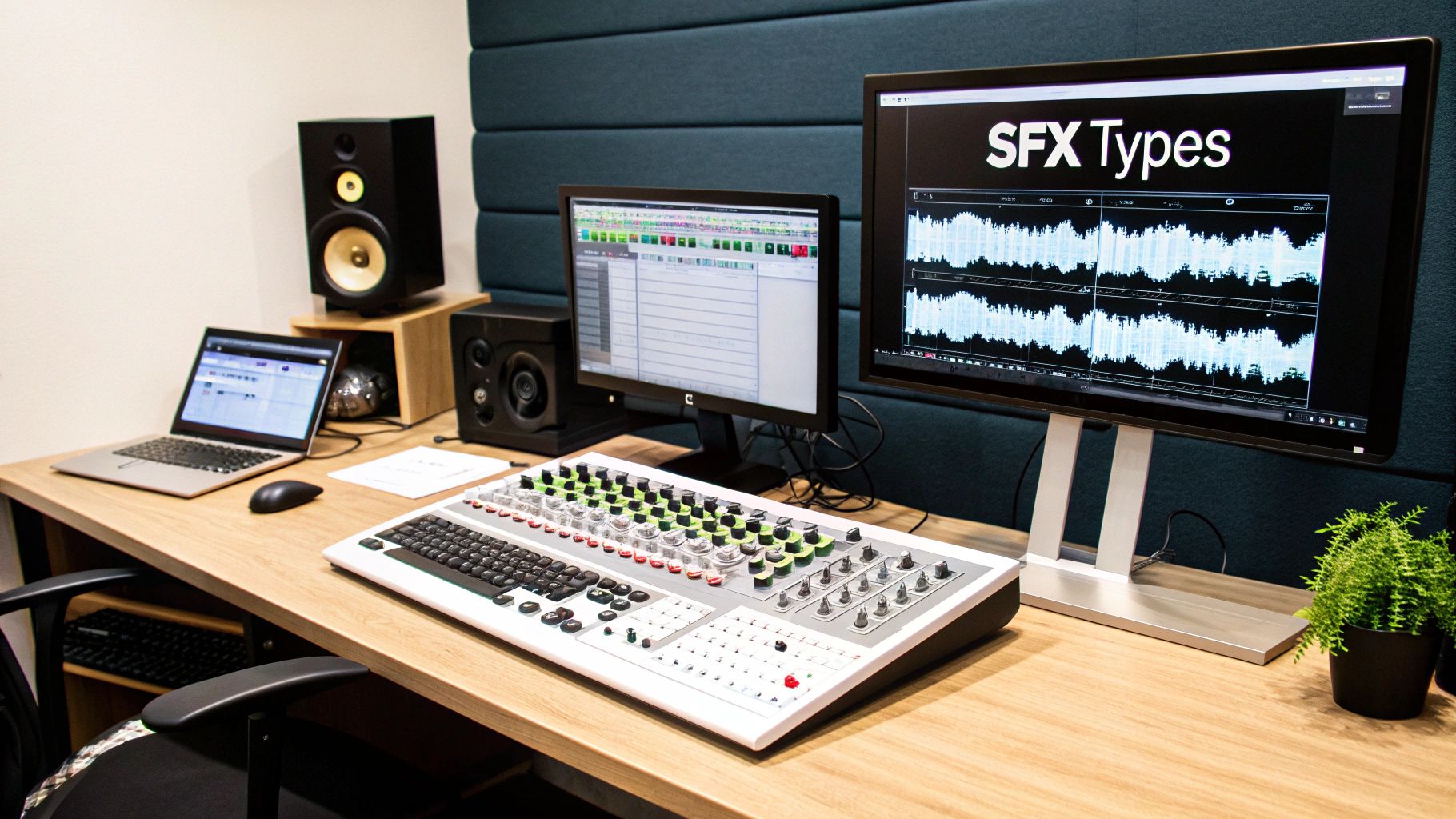
To get what you need from a site like this, you have to be precise with your keywords. Expect to download a handful of options before you find one that's actually usable for your project.
On the flip side, you have premium services like Epidemic Sound or Artlist. These are curated libraries full of professionally recorded audio. The quality is always top-notch, and the licensing is dead simple—pay a subscription, and you're covered for pretty much any project. It costs money, of course, but the time saved and the legal peace of mind are huge.
My Personal Takeaway: For any professional project, a premium subscription is a must. The time I get back from not having to worry about licensing or poor audio quality pays for the subscription fee many times over. I still dip into the free sites, but it's usually for a very specific, obscure sound that the big libraries just don't have.
If you want to see what's out there, we've put together a huge list of sources for free sound effects for video editing that breaks down the good and bad of each.
Just having the sounds isn't enough; you need a system. A logical folder structure is what keeps your library from turning into a digital junkyard you're afraid to open. Over the years, I've found that organizing everything by category is the most intuitive way to go.
This is the simple folder structure I've landed on, and it works every time:
City, Nature, Interior, and Sci-Fi. It makes grabbing the right room tone or outdoor atmosphere a two-second job.Soft, Hard, Metallic, and Digital to quickly find the right texture.The final piece of this organizational puzzle is a consistent naming convention. I stick to Category_SpecificDescription_Variation.wav (e.g., Foley_FootstepGrass_Run01.wav). This simple habit makes every single sound in my library searchable directly from my editing software. No more digging.
Sometimes, the library just doesn't have what you need. Maybe it's the unique squeak of a character's old leather jacket or the specific rattle of their keys. When that happens, it's time to step away from the computer and become your own Foley artist.
Recording your own sounds gives you total creative control. You don't need a fancy studio, either. A decent mic and a quiet room are often all it takes. I once spent an hour trying to find the right sound for a vintage camera shutter online. I gave up, pulled out my old film camera, and recorded the shutter with my phone. It sounded a thousand times more authentic than any stock effect. This DIY approach guarantees your sound design will be completely unique to your project.
Ever found yourself in a creative bind? You're editing a scene with a fantastical creature or a futuristic spaceship, and you need that one perfect sound effect... but it's nowhere to be found. Stock libraries come up empty. This used to be a major roadblock, but now it's a creative opportunity, all thanks to the way AI is shaking up sound effects video editing. Instead of hunting for the 'right' sound, you can now invent it with a simple line of text.
This isn't just a gimmick anymore; it's fast becoming a core part of the professional video editor's toolkit. The market for these AI sound tools is on an incredible trajectory, expected to leap from USD 0.9 billion in 2023 to a staggering USD 4.4 billion by 2033. This boom is all about AI's uncanny ability to generate hyper-realistic sounds and automate tedious tasks, which in turn saves a ton of production time.
The real magic behind AI sound generation happens in the prompt. If you give it a vague request, you'll get a generic, soulless sound back. The secret is to be incredibly descriptive and evocative. You need to paint a picture with your words, guiding the AI toward the exact texture and feeling you're after.
A solid prompt usually weaves together three key ingredients:
crackling, rumbling, hissing, or whirring? These words are the engine of your sound.eerie, majestic, glitching, or soothing add that crucial layer of mood and character.This image below neatly shows how any new audio, whether found in a library or generated by AI, fits into the standard video editing workflow.
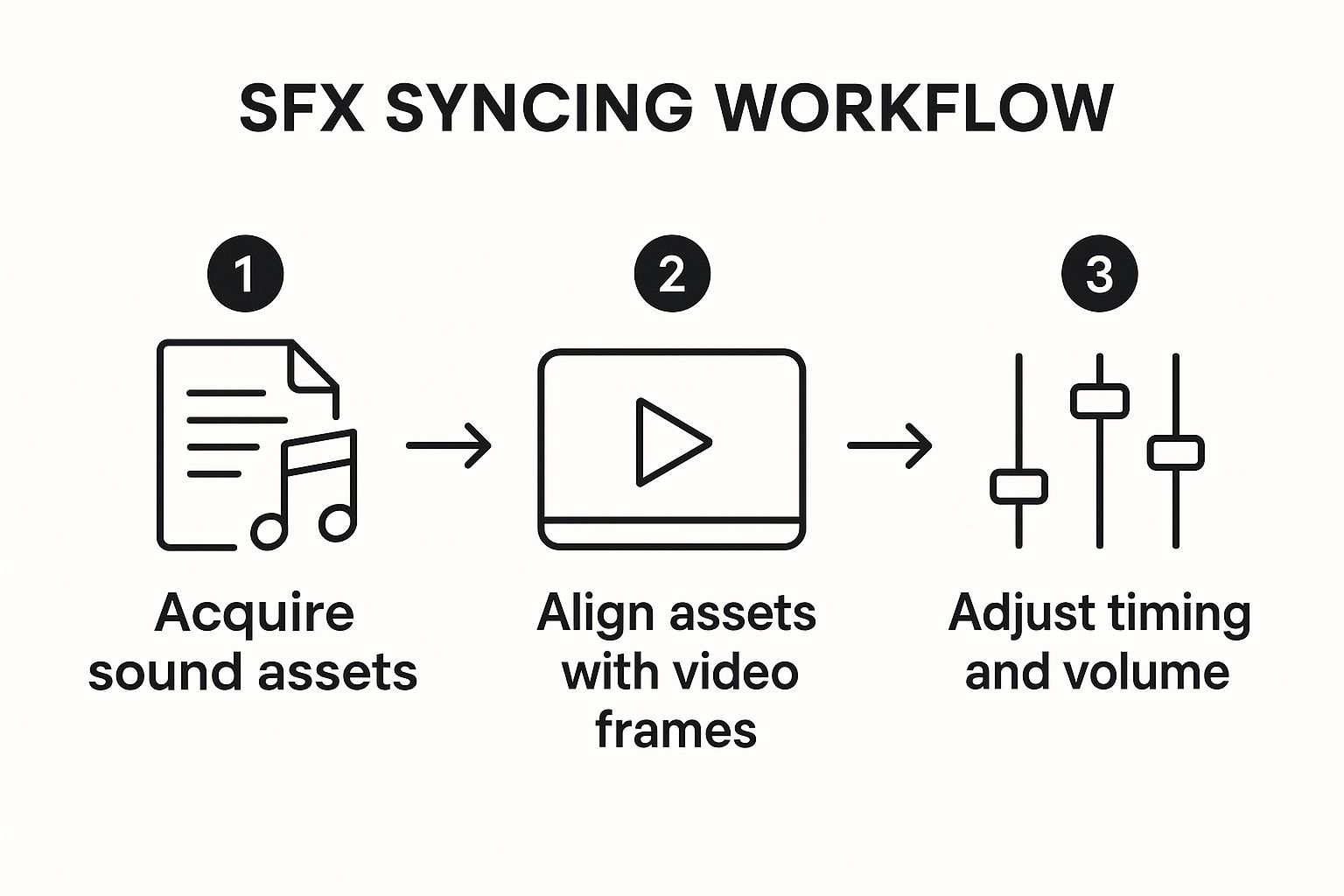
It always comes down to the same three steps: get the sound, line it up with your video, and then tweak it until it sits perfectly in the mix.
Let's look at some real-world examples. The gap between a weak prompt and a strong one is often the difference between a sound you have to discard and one that elevates your entire project.
Scenario 1: A Magical Spell
Magic spell soundA low humming energy that builds into a sharp, crystalline crackle, followed by a fading ethereal whisper and shimmering particles.Scenario 2: A Sci-Fi Interface
UI beepA short, clean, holographic beep with a subtle liquid bubble pop at the end, slightly reverberated as if in a spaceship cockpit.The goal is to give the AI enough sensory detail to work with. The more specific your language, the more unique and fitting your final sound will be. Think of it less like a search query and more like a short burst of creative writing.
This approach hands you the keys to the kingdom, creatively speaking. You're no longer limited by what someone else has recorded. Your only real constraint is what you can imagine. If this way of working excites you, our guide on how to create sounds dives even deeper into custom audio creation.
Choosing to generate custom sounds isn't just a small tweak; it fundamentally changes your creative process. It turns the workflow from a "scavenger hunt" into a "design session."
To understand this shift, let's compare the old way with the new.
| Aspect | Traditional SFX Libraries | AI Sound Generation |
|---|---|---|
| Workflow | Search, filter, audition, download, and test dozens of files. | Write prompt, generate options, refine prompt, and export the best result. |
| Creative Control | Limited to what's available; you find the "closest fit." | Near-total control; you create the "perfect fit." |
| Time Investment | Can take hours searching for a specific, unique sound. | Can generate a usable sound in minutes, but refinement takes time. |
| Uniqueness | Low. The same popular sounds appear in many productions. | High. Each sound is unique to your prompt and can be tailored. |
| Cost | Subscription fees or per-sound costs can add up. | Often subscription-based, offering unlimited generations for a flat fee. |
| Best For | Common, real-world sounds (footsteps, doors, traffic). | Unique, abstract, or non-existent sounds (sci-fi, fantasy, branding). |
The table makes it clear: instead of spending hours sifting through libraries for a sound that's almost right, you can now invest that time in crafting the exact sound you hear in your head. This is a game-changer for projects needing a distinct sonic identity.
By working with these new tools, you're not just speeding up your sound effects video editing. You're unlocking a level of auditory customization that used to be possible only for big-budget studios. You're no longer just an editor; you're an inventor.
Finding the perfect sound effect is a great first step, but it’s just that—a first step. The real magic happens in the mix, where you blend that sound into your scene so it feels like it truly belongs. A raw, unmixed sound often sticks out like a sore thumb, completely shattering the illusion you’re trying to create.
Don't worry, this isn't about becoming a professional audio engineer overnight. It's about using a few core techniques right inside your video editor to weave individual sounds into a believable and cohesive soundscape.
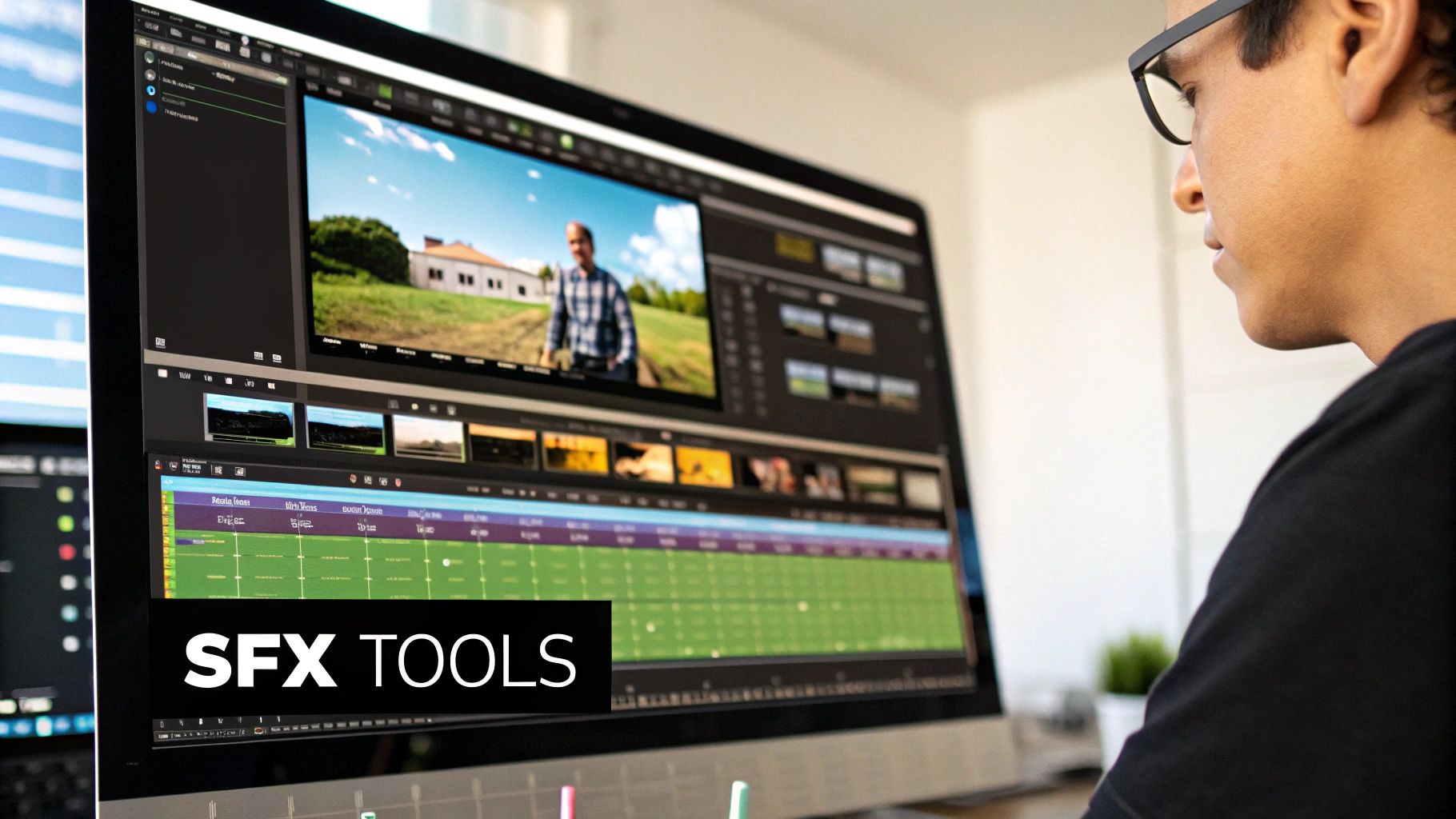
This kind of audio control is more accessible than ever. With the number of paid video editing software users projected to hit 48.22 million by 2025, the demand for better built-in audio tools is exploding. And it makes sense—nearly 85% of businesses now use video marketing, and they know that crisp, well-mixed audio is essential for grabbing and holding an audience's attention.
In the real world, sound is rarely a single, isolated event. It's a rich tapestry of overlapping noises, and recreating that feeling on screen means you need to layer your audio. This is how you build a scene that feels authentic and alive.
Think of it like painting a picture. You don't just put one color on the canvas; you build up from a base coat and add layers of detail and texture.
A scene in a busy cafe, for example, is more than just the characters talking. It's the foundation of distant chatter and clattering dishes, the focus of the main conversation, and the details of a spoon stirring sugar into a cup. Together, these layers create depth and make the world feel real.
When you have dialogue, music, and sound effects all playing at once, things can get messy. You need a way to make sure the most important audio—usually the dialogue—cuts through the noise. That's where audio ducking comes in.
It’s a simple but incredibly effective technique that automatically lowers the volume of one track (like music) when another track (like dialogue) is active.
Instead of manually riding the volume fader every time someone speaks, you can just set up ducking. When a character starts talking, the music volume gracefully "ducks" down into the background. As soon as they stop, the music swells back up. It creates a polished, professional mix without all the tedious keyframing.
You don't need a high-end audio suite for this. Most modern video editing software like Capcut Pro has a built-in ducking feature, often making it as simple as checking a box.
A footstep recorded in a quiet studio is going to sound completely out of place in a scene set in a massive, empty warehouse. To make it believable, you have to shape the sound to match its surroundings using two essential tools: Equalization (EQ) and Reverb.
Equalization (EQ) lets you adjust the tonal balance of a sound by boosting or cutting specific frequencies.
Reverb is your secret weapon for placing a sound in a physical space. It simulates the natural echoes and reflections that occur as sound bounces off surfaces. A sound with no reverb feels unnaturally "dry" and close to the listener's ear.
Imagine a character walks from a cavernous parking garage into a small, carpeted elevator.
This subtle audio shift tells the viewer's brain exactly where the character is, often before they even process the visual change. Mastering these simple mixing techniques is what elevates your sound effects video editing from just good to truly immersive.
Once your basic sound mix is in place and everything is layered nicely, the real fun begins. This is where you graduate from the technical side of sound effects video editing and start thinking like a true sound artist. We're talking about the creative choices that give your work a distinct, memorable feel—the kind of polish that makes a project stand out.
These aren't hard-and-fast rules but rather creative strategies. They’re the little sonic details that separate a decent edit from a truly compelling piece of storytelling.
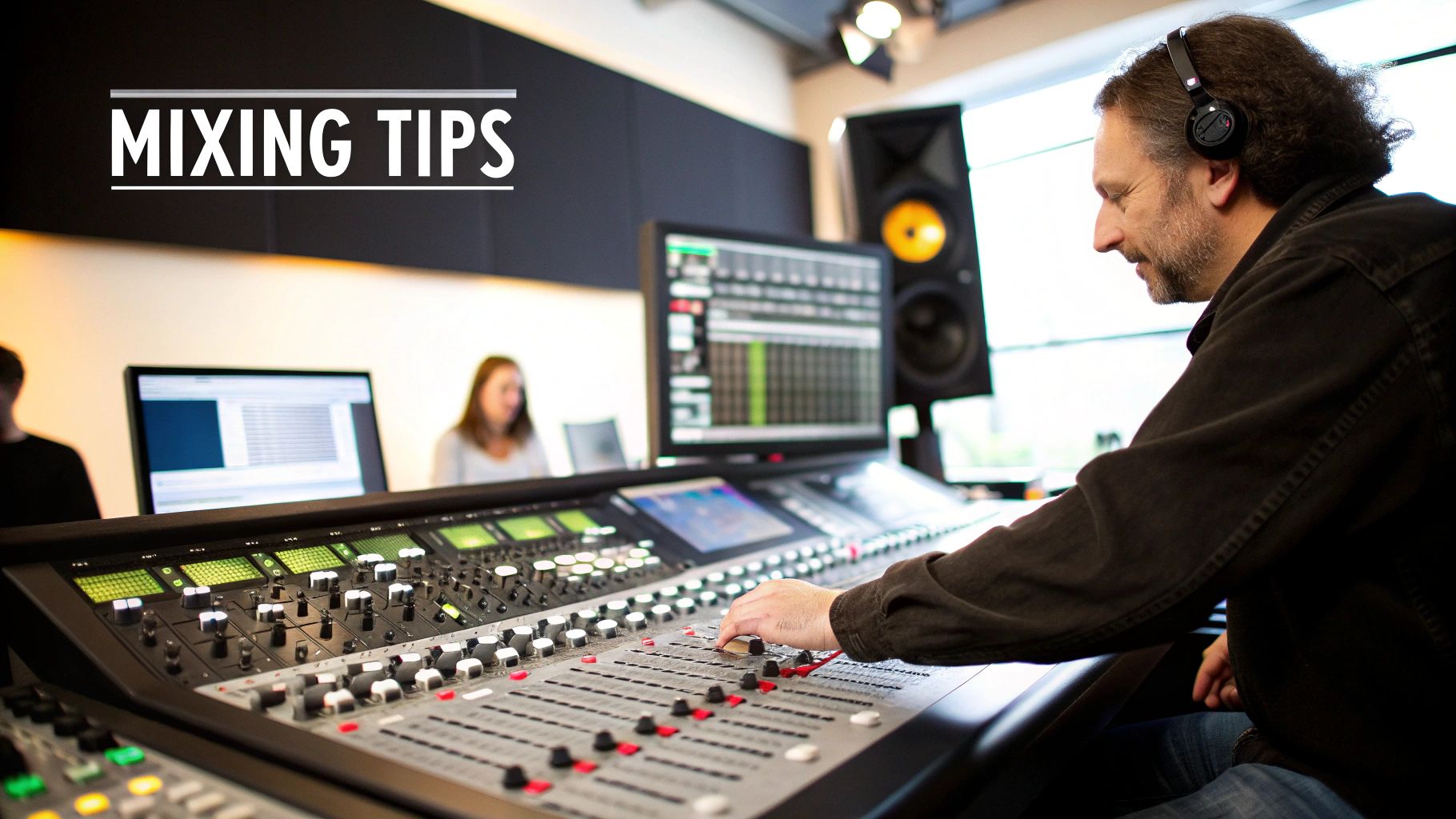
Think about the Netflix "ta-dum," the classic Intel bong, or the static crackle of HBO. What do they have in common? They're all instantly recognizable sonic logos. This is sonic branding in a nutshell: using a unique, consistent sound to create an audio signature for your brand, YouTube series, or podcast.
But it’s so much more than a jingle. Your sonic brand could be the specific whoosh you use for every on-screen graphic transition. It might be a subtle, custom chime that plays when your logo appears, or a particular notification sound in a product demo.
The key here is consistency. When your audience hears that sound, you want them to immediately connect it with your content. This simple trick builds a powerful sense of cohesion across all your videos, telling viewers they're in a familiar space and reinforcing your brand identity every single time they press play.
What happens when the sound you need isn't in your library and is just too abstract to describe to an AI? This is when you put on your sound designer hat and start manipulating existing audio. Most video editors have the tools for this built right in.
Reversing Audio: Playing a sound backward is a fantastic way to create surreal or unsettling effects. The sound of glass shattering, when reversed, becomes a magical "un-shattering" sound. A simple cymbal crash played backward transforms into a tense, rising swell that’s perfect for building suspense.
Pitch Shifting: A classic technique for a reason. Pitch down a lion's roar, and suddenly you have the menacing growl of a giant monster. Pitch up a small engine sound, and you get a futuristic sci-fi drone. It's also a great way to create subtle variations of the same effect so your audience doesn't hear the exact same footstep or punch over and over.
Distortion and Glitching: Sometimes, making a sound worse makes it better for the story. Adding digital distortion, stutters, or bit-crushing effects can perfectly signify a corrupted memory, a failing piece of tech, or even a character's fractured mental state.
For example, I love using a reversed soundscape for dream sequences. That slightly "off" quality immediately tells the audience that what they're seeing isn't quite reality, creating a surreal atmosphere without needing a single line of dialogue to explain it.
These simple tweaks can breathe new life into your existing library, turning a handful of basic sounds into an infinite creative palette.
In a world constantly filled with noise, one of the most powerful tools in sound effects video editing is its complete absence. Don't think of silence as empty space. Think of it as an active element of your sound design.
Imagine a chaotic action scene—pounding music, loud explosions, shouting. Then, for a split second, everything goes dead quiet as the hero makes a critical choice. That sudden silence forces the audience to lean in, creating an intense moment of focus and dramatic weight that no sound could ever achieve.
Here are a few ways I put silence to work:
Using silence is a bold move. It shows confidence in your storytelling and a deep understanding of rhythm and pacing. It commands attention and proves you’re in complete control of the audience's experience.
Jumping into sound design can feel a little overwhelming. You're trying to make your project sound incredible, but a ton of questions pop up along the way. Getting those sorted helps you get out of the technical weeds and back to the fun part—telling a great story.
Let's break down some of the most common questions editors run into.
This is the big one, and the right answer really boils down to your project and your budget.
For zero-cost options, community sites like Freesound.org or the library built right into YouTube are decent places to start. Just be prepared to do some digging. You'll spend a good bit of time sifting through files to check the quality and making sure you understand the specific license for each sound.
Honestly, for any serious or commercial project, a subscription service is a lifesaver. Platforms like Epidemic Sound or Artlist have massive, high-quality libraries with dead-simple commercial licenses. The small investment pays for itself by saving you from potential legal trouble and countless hours of searching for a usable clip.
The trick isn't just finding the right sound; it's making it live in the world you're creating. A single, naked "footstep" sound dropped onto a timeline will always stick out like a sore thumb. Realism comes from layering and context.
You need to build a tiny audio environment around that main sound.
You'll know you've nailed it when the sounds stop feeling like individual effects and just become part of the scene. The goal is to make the audience feel it, not just hear it.
People throw these terms around a lot, but they each have a specific job in your sound design. Getting a handle on their roles is a game-changer for building a rich sound effects video editing workflow.
Think of it like this:
AI is an amazing new tool in our kit, but it's not a magic wand that solves every problem.
It's absolutely brilliant for creating sounds that don't exist in the real world. Need the crackle of a magic spell, the hum of a sci-fi engine, or the specific cry of a mythical creature? AI is perfect for that kind of abstract or imaginative sound design.
But if you need something hyper-specific from the real world—like the exact sound of a 2023 Honda Civic's door closing—you're still better off grabbing it from a traditional, pre-recorded library. It’s just faster and more accurate. The smartest workflow uses both: lean on your library for realism and turn to AI when you need to invent something totally new.
Ready to stop searching and start creating? SFX Engine lets you generate unique, royalty-free sound effects from a simple text prompt. It's perfect for editors who need that one-of-a-kind sound without the headache. Try SFX Engine for free and bring your sonic vision to life.